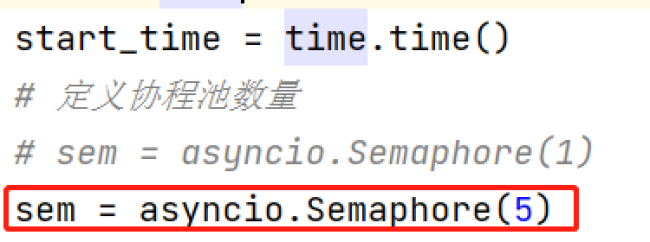项目作业-异步执行速度
相关代码:
#!/usr/bin/env python3
# -*- coding=utf-8 -*-
import asyncio
import aiohttp
import re
from lxml import etree
import pymongo
# 请求并将数据丢到html_queue的队列中
async def request(session, html_queue, sem, url_queue):
# 传入处理协程数量
async with sem:
# 取出url_queue的数据
url = await url_queue.get()
# 异步的方式去request豆瓣的电影页面的HTML
async with session.get(url) as resp:
data = await resp.text()
# 将数据丢入到html_queue的队列中
await html_queue.put(data)
# 将html_queue队列中的数据取出,处理后写入到DB中
async def handle(html_queue, lock, mycollection):
# 将队列中的数据取出
html_text = await html_queue.get()
# 将数据丢到etree中处理
html = etree.HTML(html_text)
for li_number in range(1, 26):
#################### 整理数据 ####################
# 整理相关电影资讯
movie_path = html.xpath(
f'// *[ @ id = "content"] / div / div[1] / ol / li[{li_number}] / div / div[2] / div[1] / a/span/text()')
movie_name_list = []
for name in movie_path:
# 将电影名称的空白消除
movie_name_list.append(re.compile(r'(\s)+/(\s)+').sub('/', name))
movie_name = ''.join(list(filter(None, movie_name_list)))
actors_path = html.xpath(f'//*[@id="content"]/div/div[1]/ol/li[{li_number}]/div/div[2]/div[2]/p/text()')
ac_list = []
for ac in actors_path:
# 将演员资讯之间的空白消除,以及换行消除
ac_result = re.compile(r'(\s)/(\s)').sub('/', re.compile(r'[\n]|[\s]{2,}').sub('', ac))
ac_list.append(ac_result)
actors_information = ''.join(list(filter(None, ac_list)))
score_path = html.xpath(
f'//*[@id="content"]/div/div[1]/ol/li[{li_number}]/div/div[2]/div[2]/div/span[2]/text()')
score = ''.join(score_path)
evaluate_path = html.xpath(
f'//*[@id="content"]/div/div[1]/ol/li[{li_number}]/div/div[2]/div[2]/div/span[4]/text()')
evaluate = ''.join(evaluate_path)
describe_path = html.xpath(
f'//*[@id="content"]/div/div[1]/ol/li[{li_number}]/div/div[2]/div[2]/p[2]/span/text()')
describe = ''.join(describe_path)
# 创建一个字典将资料都放入其中
info = {
'movie_name': movie_name,
'actors_information': actors_information,
'score': score,
'evaluate': evaluate,
'describe': describe
}
# 将数据丢到DB中
async with lock:
mycollection.insert_one(info)
# 定义异步主程序
async def main():
import time
start_time = time.time()
# 定义协程池数量
sem = asyncio.Semaphore(1)
header = {
"Accept": "text/html,application/xhtml+xml,application/xml;q=0.9,image/webp,image/apng,*/*;q=0.8,application/signed-exchange;v=b3",
"Accept-Encoding": "gzip, deflate",
"Accept-Language": "zh-CN,zh;q=0.9",
"Connection": "keep-alive",
"Host": "movie.douban.com",
"Upgrade-Insecure-Requests": "1",
"User-Agent": "Mozilla/5.0 (Windows NT 10.0; WOW64) AppleWebKit/537.36 (KHTML, like Gecko) Chrome/73.0.3683.86 Safari/537.36"
}
# 生成url数据,并丢到url_queue队列中
url_queue = asyncio.Queue()
for page in range(0,226, 25):
url = f"https://movie.douban.com/top250?start={page}"
await url_queue.put(url)
# 调用request异步函数
html_queue = asyncio.Queue()
async with aiohttp.ClientSession(headers=header) as session:
while not url_queue.empty():
await request(session, html_queue, sem, url_queue)
# 实例化mongo client
m_client = pymongo.MongoClient('mongodb://account:password@172.16.1.10:27017')
mydb = m_client['movie']
mycollection = mydb['movie_info']
# 生成lock,并调用handle异步函数
lock = asyncio.Lock()
while not html_queue.empty():
await handle(html_queue, lock, mycollection)
end_time = time.time()
print(end_time-start_time)
if __name__ == '__main__':
# 开始循环
loop = asyncio.get_event_loop()
loop.run_until_complete(main())问题描述:
你好,为什么通过异步爬取会比多线程还要慢?
我的理解是每次异步request之后,就会马上换下一个request,因此并不会阻塞IO
而多线程则是通过大量的线程去减少阻塞IO的时间
我认为两者的时间在这个作业里面应该是差不多的,但是实际运行异步所消耗的时间约为多线程的两倍,让我不知道是不是异步哪里的逻辑出了问题,可能实际上还是有阻塞的部份我没看出来
因此想请教一下
29
收起
正在回答 回答被采纳积分+1
Python全能工程师
- 参与学习 人
- 提交作业 16421 份
- 解答问题 4469 个
全新版本覆盖5大热门就业方向:Web全栈、爬虫、数据分析、软件测试、人工智能,零基础进击Python全能型工程师,从大厂挑人到我挑大厂,诱人薪资在前方!
了解课程






















恭喜解决一个难题,获得1积分~
来为老师/同学的回答评分吧
0 星